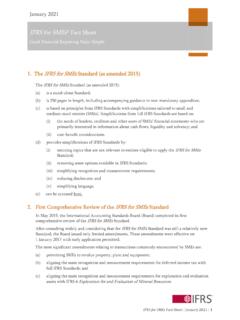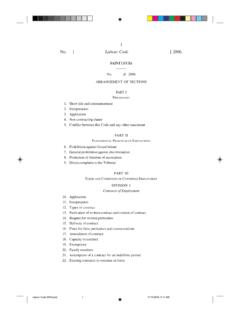Transcription of Family Violence in the Caribbean - United Nations
1 Gibbons. A., Family Violence in the Caribbean Page 1 of 17 Family Violence in the Caribbean Allison. Y. Gibbons, , CFLE Associate Professor, Family & Child Studies McNeese State University, Lake Charles, Louisiana Presentation Expert Group Meeting on Family policy development: achievements and challenges United Nations Headquarters New York, 14-15 May 2015 The Caribbean in Context The region of the world known as the Caribbean is an archipelago of islands that form the boundaries of the Caribbean Sea, from the southernmost tip of North America down to the northern coast of South America. Some islands in the Atlantic Ocean and a few countries on the coasts of South and Central America self-identify, politically and culturally as Caribbean . The region reveals a mix of joint and separate histories with English, Dutch, French and Spanish colonial control.
2 The close of the 20th century saw the formation of a politically unifying force among the English-speaking Nations known as the Commonwealth Caribbean , now referred to as the CARICOM region(CARICOM, 2011a, 2011b), and includes 14 member states: and five associates. The group comprises: Antigua & Barbuda, Barbados, British Virgin Islands, Dominica, Grenada, Jamaica, saint Kitts & Nevis, saint lucia , saint Vincent & The Grenadines, and Trinidad & Tobago. Members in the Atlantic include the Bahamas, Bermuda and Turks & Caicos. On the mainland are Belize in Central America, and Guyana in South America. There are two exceptions to the English speaking history of CARICOM membership - Suriname, located on the coast of South America, of Dutch heritage; and HAITI in the north with French as its official language.
3 The population of the region is 16 million, with 7 million in Haiti alone (CARICOM 2007, 2011c). Under this specific Caribbean context, island Nations such as the Spanish speaking Cuba, Dominican Republic and Puerto Rico are omitted along with the United States Virgin islands and the other Dutch and French territories lying in the Caribbean Sea, all of whom can fall between the cracks of research and documentation for various reasons. An examination of policies and UN activities in the region can become complicated. Some analyses may view the Caribbean from the perspective of the CARICOM collective. Other analyses lump all islands that are situated in the Caribbean Sea under the header of Latin America and the Caribbean which can be misleading or only minimally informative. Based on population numbers, the islands can be rendered insignificant next to the populous countries of Central and South America.
4 Writers and researchers of Caribbean heritage tend to demonstrate more attention to specifics in covering the Caribbean diaspora. Writing about Family Violence in the Caribbean demands this type of attention to detail since we are dealing with a complex region of self-governing micro- Nations (Gibbons, 2013). Scholars who study Family Violence agree that Family Violence occurs in all cultures and that regardless of cultural differences and geography, there are common elements across all societies such as the social and economic toll and the constraints that block progress in eliminating it. The Caribbean islands may appear to be dots on the map of the world, but the issues of the region are representative of the challenges of confronting Family Violence anywhere whether in a micro-nation in the third world or a powerful first world country.
5 Unfortunately, Family Violence is a unifying global concept. It is the shadow that haunts human rights efforts everywhere. Gibbons. A., Family Violence in the Caribbean Page 2 of 17 Defining Family Violence Family Violence is a term used interchangeably with domestic Violence in discourse among Family scholars; it covers physical, social and emotional abuse and acts of aggression within relationships that are considered as Family connections or akin to Family connections. In the broader arena of global conferencing, policy-making, research, and documentation, there is inconsistency in its application, and it is not unusual to encounter double descriptors in the literature such as domestic Violence and intimate partner Violence . Gradually, researchers, scholars and legal experts have begun to accept the broader concept of Family Violence to include married couples, intimate partners whether living together or dating, and Violence between parents and children.
6 The concept further reaches into other areas of the Family that were excluded from scrutiny in times past such as sibling Violence , child to parent Violence , elder abuse, and Violence between close relatives such as uncles and their nieces and nephews, grand-parents and grand-children, adopted parents and adopted children, foster parents and foster children, step-parents and their step-children plus step-siblings. With the growing acceptance of same-sex intimate partnerships and marriage, Family Violence also encompasses such confrontations within lesbian, gay and transgender couples and their families. Many researchers and scholars are reluctant to describe as Family Violence , aggressive acts between casual intimate partners or between former partners and ex- spouses and lean towards the term, Intimate Partner Violence (IPV).
7 Questions also arise on whether or not to count statistically Violence that is known to occur with dating couples. In the US for example, the phrase dating couple may cover the spectrum of teens having a romantic relationship that may include sexual activity, right up to committed unmarried couples who are linked romantically and socially but perhaps not domestically. In this presentation, the term Family Violence will be used comprehensively for the most part, but domestic Violence and intimate partner Violence will also be used if that is the way they are referenced in specific literature and published reports. Understanding Family Violence through Family Science Through the discipline of Family Science, practitioners study the internal dynamics of families, the changing structure and roles of families, formal and informal dimensions of Family , and the interface between Family and the society.
8 Family professionals are clear that Family is the first environment in which gender roles and expectations are transmitted and entrenched, where patterns of Violence are established and rationalizations for gender-based Violence are formulated (Barnett et al, 2005; McCue, 2008; NRC, 1998). In the interface between Family and society, the feedback of social and cultural acceptance of Family Violence strengthens the perceptions learned within the Family , thus leading to spill-over into the society at large of Violence as a means of for problem-solving, gaining or re-acquiring dominance over someone else. This recursive reinforcement of a norm of Violence underlies the uphill battle faced over the years by all advocates against Family Violence . Despite the progress made internationally on the wording and ratifications of legal conventions and declarations condemning domestic Violence specifically, and Violence against women generally, evidence points to the fact that Family Violence persists at high and increasing rates.
9 Among Family scholars following the evidence (Gelles, 2010), there is consensus that Family Violence is a serious societal problem. It is widely known that Violence against women and girls is a major expression of power and control within the Family and society. Laws that seek to protect women can be perceived as laws that wrest authority away from men, setting up an atmosphere of antagonism at the level of policy-makers, law enforcers, the courts, and tensions within the Family itself. Finding effective responses to global Violence against women and children demand that we examine the roots of culture within which gender-based Violence Gibbons. A., Family Violence in the Caribbean Page 3 of 17 resides. This starts with re-educating Nations about the power of Family -based patterns of behavior as a foundation for Violence in the society.
10 Laws can prescribe, pressure and punish, but laws by themselves do not change behavior that is as deeply rooted as Family Violence . The current challenge is to explore the problems associated with operationalizing the new laws within the context of the Family -based factors that impede progress. Theoretical perspectives embraced by Family scholars can be the foundation for programs aimed at reducing Family Violence . These include Social Learning theory which explains that Family Violence is learned and can be unlearned (Bandura, 1973); General Strain Theory which acknowledges that Family and social stressors can trigger Violence and that resolution of strains can minimize violent outbursts (Agnew, 1992); Pro-feminist theory which supports the human rights of women and girls and also promotes programs to reduce patterns of patriarchy in society (Dobash & Dobash, 1979); Ecological theory which underpins the connections between Family and society, explains the complexities of inter-relationships within the home and Family , and supports community-based interventions.












